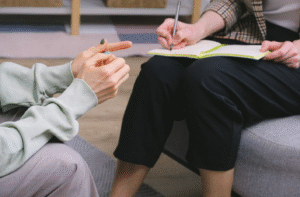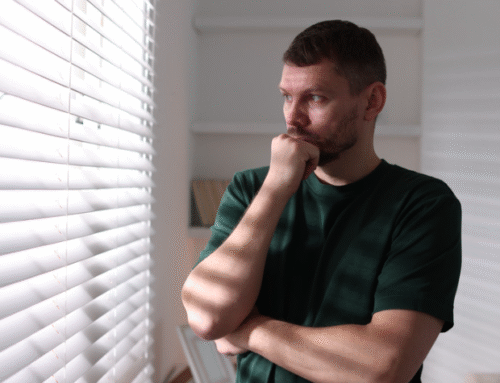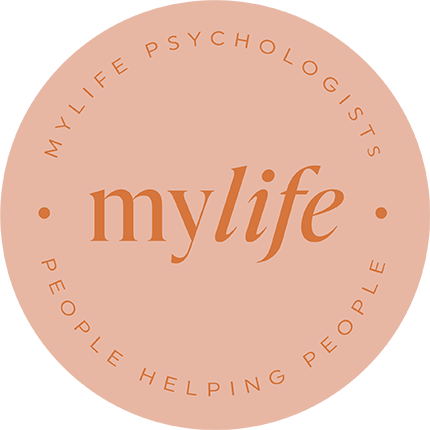For many people, anxiety can take on different shapes and intensities. Two of the most commonly confused conditions are agoraphobia and social anxiety disorder (social phobia). While both involve significant fear and avoidance, they are distinct in their triggers, symptoms, and treatment approaches. Understanding these differences is key to seeking the right support and beginning the path toward recovery.
At MyLife Psychologists in Sydney, we help adults and adolescents navigate complex anxiety disorders, including agoraphobia and social anxiety. This article explores the similarities and differences between the two conditions, how they affect daily life, and the treatment options available.
What is Agoraphobia?
Agoraphobia is an anxiety disorder characterised by intense fear of situations where escape may feel difficult or help might not be available if panic symptoms arise. People with agoraphobia often worry about being trapped, losing control, or experiencing panic in public.
Common triggers for agoraphobia:
- Crowded places like shopping centres, public transport, or concerts
- Open spaces (parks, pedestrian malls) or enclosed spaces (lifts, cinemas)
- Travelling away from home alone
- Standing in queues or being in situations with limited exits
Key symptoms:
- Fear or avoidance of at least two or more situations (e.g., crowds and public transport)
- Panic attacks or strong anxiety when facing feared situations
- Reliance on a “safe person” or avoidance of leaving home altogether
- Physical symptoms such as rapid heartbeat, dizziness, sweating, or shortness of breath
Without treatment, agoraphobia can become severely disabling, sometimes leading to the person rarely leaving their home.
What is Social Anxiety Disorder?
Social anxiety disorder (or social phobia) is defined by a persistent fear of social or performance situations where embarrassment, humiliation, or negative judgment from others is possible. The fear centres not on escape or safety, but on how one is perceived.
Common triggers for social anxiety:
- Speaking in front of groups or giving presentations
- Attending social gatherings or meeting new people
- Being observed while eating, drinking, or working
- Fear of saying something “stupid” or blushing, shaking, or sweating in public
Key symptoms:
- Intense fear of being judged or criticised
- Avoidance of social events or enduring them with extreme distress
- Physical symptoms such as blushing, trembling, nausea, or dry mouth
- Negative self-talk and rumination after social interactions
Social anxiety often begins in adolescence and, if untreated, can significantly interfere with education, career, relationships, and overall wellbeing.
Agoraphobia vs Social Anxiety: The Key Differences
Although both disorders involve avoidance and intense anxiety, their focus of fear is different:
| Aspect | Agoraphobia | Social Anxiety Disorder |
| Core Fear | Being trapped or unable to escape in case of panic | Negative judgment, embarrassment, or humiliation |
| Situations Avoided | Public transport, crowds, being away from home | Social gatherings, public speaking, meeting strangers |
| Onset | Often develops after panic disorder or panic attacks | Often begins in adolescence, sometimes without panic |
| Physical Symptoms | Panic attacks, dizziness, breathlessness | Blushing, trembling, nausea, sweating |
| Impact | May become housebound, rely on others to go out | Avoids relationships, career or study opportunities |
Understanding these distinctions is important for both accurate diagnosis and effective treatment planning.
Overlap Between the Two
It’s not uncommon for someone to experience both conditions. For example, a person with social anxiety may start avoiding social places, and over time this avoidance could extend into agoraphobia. Similarly, someone with panic disorder may develop agoraphobia and also worry about being judged for their panic symptoms, triggering social anxiety.
Because the symptoms can overlap, a thorough assessment by a psychologist is essential.
Treatments for Agoraphobia
The good news is that agoraphobia is highly treatable. Psychologists use treatments that have been well-researched and proven to help people reduce anxiety and regain confidence in daily life.
Cognitive Behavioural Therapy (CBT):
CBT is the most effective treatment for agoraphobia. It helps you:
- Understand the link between your thoughts, feelings, and behaviours.
- Challenge unhelpful fears like “I won’t be able to cope if I have a panic attack.”
- Learn coping tools to manage anxiety.
- Practice gradually facing feared situations so they become less overwhelming.
Exposure Therapy:
A key part of CBT, exposure therapy means gently and gradually practicing the situations you fear – like getting on a bus or going to the shops – with the guidance of a psychologist. Over time, your brain learns that these situations are safe, and the anxiety lessens.
Acceptance and Commitment Therapy (ACT):
ACT is another evidence-based approach that can be very helpful for agoraphobia. Instead of trying to get rid of anxiety altogether, ACT teaches you how to respond differently to anxious thoughts and feelings. The goal is not to eliminate discomfort but to stop anxiety from controlling your life.
Psychodynamic Therapy:
Psychodynamic Therapy explores underlying emotional conflicts, relationship patterns, and early experiences that contribute to anxiety and avoidance. It helps clients gain insight and reduce unconscious triggers for their fears.
Treatments for Social Anxiety Disorder
Like agoraphobia, social anxiety disorder is highly treatable. Psychologists use therapies that research shows are effective in reducing fear, building confidence, and helping people re-engage with the parts of life they’ve been avoiding.
Cognitive Behavioural Therapy (CBT):
CBT is the most effective treatment for social anxiety. It helps you:
- Identify unhelpful thoughts like “Everyone will think I’m stupid” or “I’ll embarrass myself.”
- Challenge these beliefs with more balanced, realistic ways of thinking.
- Learn practical coping strategies for managing anxiety in the moment.
- Use exposure exercises to gradually face social situations (e.g., starting a conversation, giving a short presentation) in a safe, structured way.
Research shows that CBT can significantly reduce social anxiety symptoms and improve confidence over time.
Group Therapy:
Group therapy is often recommended for social anxiety because it provides a safe and supportive environment to practise new skills. In a group, you can:
- Learn you’re not alone in your struggles.
- Practise conversations, role-plays, and presentations.
- Receive feedback and encouragement from both peers and the psychologist.
Many people find group therapy empowering, as it allows them to face social fears directly in a structured, caring setting.
Acceptance and Commitment Therapy (ACT):
ACT helps you change your relationship with anxiety. Instead of trying to “switch off” anxious thoughts or feelings, ACT teaches you how to:
- Notice and accept anxiety without letting it control your behaviour.
- Focus on your personal values, such as friendship, learning, or career goals.
- Take small, meaningful steps toward those values, even while feeling nervous.
This approach helps reduce avoidance and builds confidence in living a full, connected life.
Social Skills Training:
Sometimes, people with social anxiety feel they lack confidence in certain skills—like starting a conversation, maintaining eye contact, or speaking in front of others. Social skills training provides:
- Role-play practice in a safe environment.
- Constructive feedback to improve communication.
- Techniques for assertiveness and expressing needs clearly.
Schema Therapy:
Schema Therapy is particularly helpful when social anxiety is linked to deeply held beliefs about the self, often developed early in life. For example, beliefs such as “I’m unlovable,” “I’ll always be rejected,” or “I’m not good enough.”
This approach involves:
- Identifying and understanding long-standing “schemas” or patterns of thinking.
- Exploring where these beliefs came from (often in childhood or adolescence).
- Learning new, healthier ways of relating to yourself and others.
- Using techniques such as imagery, chair work, and limited reparenting to heal emotional needs that weren’t met in the past.
Schema Therapy can be especially powerful for people who feel their social anxiety is part of a broader pattern of low self-worth, shame, or difficulty in relationships.
Why Professional Help Matters
Both agoraphobia and social anxiety can feel overwhelming, but they are highly treatable. Working with a psychologist provides structured support, personalised treatment, and evidence-based strategies that empower you to reclaim your life.
At MyLife Psychologists, our team understands how isolating and exhausting anxiety can be. We provide compassionate, professional care tailored to your needs – whether you’re facing the fear of leaving home or the dread of social situations.
When to Seek Help
Consider reaching out for professional support if:
- Your anxiety is limiting your daily life, work, or relationships
- You avoid situations because of fear or panic
- You’ve experienced ongoing anxiety for more than six months
- Self-help strategies have not been enough
Final Thoughts
Agoraphobia and social anxiety disorder are both challenging conditions, but with the right treatment, recovery is possible. While agoraphobia is rooted in fears of being trapped or unsafe, social anxiety is centred on fear of judgment and embarrassment. Recognising these differences can help you seek the right kind of support and move toward a life with greater freedom, connection, and confidence.
If you’re struggling with anxiety, you don’t have to face it alone. Contact us to book a free 15-minute call with our Care Coordinator today and take the first step towards support.
References and Resources
- Beyond Blue. (2024). Social anxiety disorder.
- Black Dog Institute. (2024). Anxiety disorders.
- Mayo Clinic. (2024). Agoraphobia: Symptoms and causes.
- National Institute for Health and Care Excellence (NICE). (2013). Social anxiety disorder: recognition, assessment and treatment.
- National Health and Medical Research Council (NHMRC). (2019). Australian Guidelines for the Treatment of Anxiety Disorders.
- Beyond Blue. (2024). Agoraphobia.







